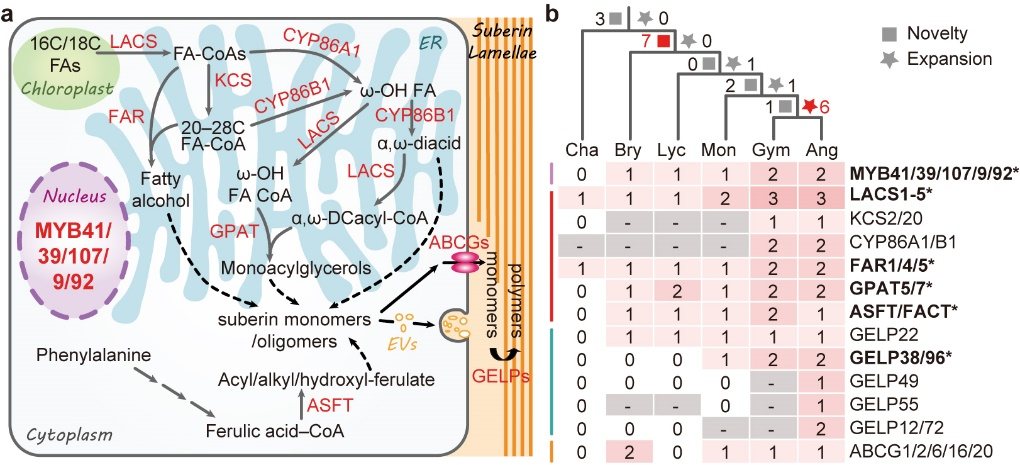On 6th November 2023, the internationally renowned academic journal Nature Plants published online a research paper titled 'The evolutionary innovation of root suberin lamellae contributed to the rise of seed plants,' which was jointly completed by the Research Group of Dai-Yin Chao at CEMPS (Chinese Academy of Sciences Center for Excellence in Molecular Plant Sciences) and the Research Group of Shiyou Lü at Hubei University. This study, for the first time, reveals the mystery behind the rise of seed plants from the perspective of specialized cell wall evolution.
Seed plants are the most advanced plant group in the world and currently dominate the planet, accounting for two-thirds of all plant species, shaping the predominant flora of our world. However, the Earth was very different over 300 million years ago during the Carboniferous period. Although seed plants had appeared more than 100 million years ago, the dominant flora of that time still belonged to ferns, with towering tree ferns dominating the ecological landscape. Most of the coal resources on Earth today came from fern plants of that period, hence the name "Carboniferous." Paleontological research reveals a turning point at the end of the Carboniferous period. It was during this period that Earth's climate suddenly became cold and arid. Fern plants began to decline, paving the way for the rise of seed plants. This significant event in evolutionary history is surrounded by many unsolved mysteries, with one of the most critical questions being what specific advantages seed plants evolved to transition from a weaker position to a thriving one by the end of the Carboniferous period.
Roots are the essential organs for plants to absorb and transport water and mineral nutrients, and the endodermis is the core of root control over water and mineral transport. The endodermis cell wall features a hydrophobic lignin-based Casparian strip that tightly anchors to the endodermal cell membrane, forming a barrier to prevent the free diffusion of substances. Additionally, there is another specialized cell wall structure, the suberin lamellae, that envelops the entire surface of the endodermal cells. Research indicates that both the Casparian strip and suberin lamellae play essential roles in plant nutrient balance and water transport, but their functions are significantly different. In the past months, the research group led by Prof. Dai-Yin Chao has made breakthroughs in the formation and anchoring of the Casparian strip, with related work published in Science and Nature Plants. However, the evolutionary basis of suberin lamellae and its role in plant evolution remained unknown.
This study employed a series of advanced cell biology and analytical chemistry techniques to conduct in-depth research on representative plant species from 18 different evolutionary nodes, with the aim of unveiling the secrets of the origin of the Casparian strip and suberin lamellae. Surprisingly, the study found that the Casparian strip exists in all vascular plants, including ferns, lycophytes, gymnosperms, and angiosperms, while suberin lamellae are only present in gymnosperms and angiosperms (both collectively referred to as seed plants). This evidence suggests that the Casparian strip and suberin lamellae did not originate simultaneously; the former emerged from the common ancestor of all vascular plants, while the latter evolved in the common ancestor of seed plants. This result challenges the longstanding assumption in plant biology regarding suberin lamellae and opens new perspectives for studying the evolution of these structures.

Figure 1: Suberin lamellae was only observed in the roots of seed plants.
To investigate how suberin lamellae evolved in the common ancestor of seed plants, the research team conducted molecular evolutionary analyses of the genes involved in suberin lamellae formation and their homologs. The results showed that although most of these genes had evolved before the appearance of vascular plants, there was significant expansion in the common ancestor of seed plants. This expansion suggests that gene duplication likely led to functional innovations, enabling the genes responsible for synthesizing suberin lamellae to emerge in the common ancestor of seed plants. To confirm this hypothesis, the team further investigated homologous genes of the core MYB transcription factors involved in suberin formation in fern plants, lycophytes, gymnosperms, and angiosperms. These genes were found to be widespread in all these plant groups, but in the common ancestor of gymnosperms and angiosperms, a significant expansion of homologous genes occurred. The study revealed that the expanded homologous genes in gymnosperms and angiosperms could initiate suberin lamellae formation, while the homologous genes in fern plants and lycophyte plants had no such function. This confirmed that the function of MYB transcription factors initiating suberin synthesis was acquired in seed plants through gene expansion.

Figure 2: Molecular evolutionary analyses of the genes involved in suberin lamellae formation.
As fern plants began to decline, and seed plants began to rise in the late Carboniferous period, when Earth's climate became dry. Suberin has waterproof properties, and the research team hypothesized that the emergence of suberin lamellae might have contributed to the drought adaptability of seed plants, promoting their rise after the onset of arid conditions. Researchers confirmed this hypothesis by using two Arabidopsis genetic materials with suberin defects, demonstrating that suberin-deficient Arabidopsis was more sensitive to drought. Furthermore, Raman spectroscopy and nuclear magnetic resonance revealed the crucial significance of suberin lamellae in enhancing the efficiency of vascular water transport. The results showed that since water molecules are capable of free diffusion across cell membranes in the absence of suberin lamellae, plants without suberin lamellae, such as ferns and horsetails, experience a significant leakage of water from endodermal cell membranes when subjected to osmotic stress, resulting in low transport efficiency. Seed plants, with suberin lamellae fully enveloping their endodermal cells, almost completely block the pathway of free diffusion of water molecules. Thus, their water leakage rate under osmotic stress is only 1%-2% compared to fern plants and lycophyte plants. This waterproofing effect greatly enhances the efficiency of water transport in the vascular tissues of seed plants under drought conditions, thereby increasing their drought resistance. Based on this, the researchers proposed a model for the rise of seed plants: under the moist climate of the Carboniferous period, fern plants with no suberin lamellae had higher water and nutrient absorption efficiency and were better adapted to the environment, thus thriving. However, during the late Carboniferous period, the onset of a dry climate provided an advantage for seed plants that had evolved suberin lamellae. They possessed a more efficient water transport system and stronger drought tolerance, gradually replacing ferns and becoming the dominant life forms on Earth's surface.

Figure 3: Suberin lamellae promotes water use efficiency in arid conditions and drought tolerance enhancing the efficiency of vascular water transport.
This study not only unveils the mystery of the origin of the Casparian strip and suberin lamellae but also, for the first time, provides evidence that the emergence of suberin lamellae drove the rise of seed plants from a new perspective. Furthermore, the research identifies the important role of suberin lamellae in plant adaptation to adverse conditions such as drought. As a result, this research has significant implications for enhancing plant drought resistance, elucidating plant salt and drought tolerance mechanisms, and developing drought-resistant crop varieties.
Yu Su, a Ph.D. student from the Research Group of Prof. Dai-Yin Chao and Tao Feng, a former postdoctoral fellow supervised by Prof. Shiyou Lü, are the co-first authors of this paper. Prof. Dai-Yin Chao and Prof. Shiyou Lü are the corresponding authors of the paper. Prof. Lin Xu and Associate Prof. Hui Shen from CEMPS were also involved in this work. This research was supported by the National Natural Science Foundation of China, the Chinese Academy of Sciences, and the Royal Society .
Link:
Contact:
Dr. Daiyin Chao, Professor
National Key Laboratory of Plant Molecular Genetics, Center for Excellence in Molecular Plant Sciences, Chinese Academic of Sciences
Email: dychao@cemps.ac.cn

